Deleted
Deleted Member
Posts: 0
|
Post by Deleted on Aug 12, 2019 1:49:15 GMT -5
Sogdian Art in Contemporary China
The impact of Sogdian art on contemporary Chinese culture is significant. It can be felt strongly in both academic research and popular culture. In academia, Sogdian art has been well researched; many articles and books by today’s most renowned historians have covered Sogdian art.
In the popular realm, Sogdian art is no less prominent. It appears frequently in art exhibitions, best-selling books, TV dramas, and even theme parks. Recently, everyone on Chinese social media seemed to be talking about a historical drama called “Longest Day in Chang’an,” which is something like a Sherlock Holmes series set in the capital of the Tang dynasty. In this drama, you see frequent representations of Sogdian immigrants and their arts. Recreation of Sogdian Lampas Robe in “Longest Day in Chang’an” (2019)Nowadays, Sogdian sarcophagi and other examples of Sogdian art can be seen at many museums in north and northwest China. For those who are interested, I recommend visiting the Shaanxi Museum (Xi’an, Shaanxi Province), the Xi’an Municipal Museum (Shaanxi Province), and the Shanxi Museum (Shanxi Province). Recreation of Sogdian Lampas Robe in “Longest Day in Chang’an” (2019)Nowadays, Sogdian sarcophagi and other examples of Sogdian art can be seen at many museums in north and northwest China. For those who are interested, I recommend visiting the Shaanxi Museum (Xi’an, Shaanxi Province), the Xi’an Municipal Museum (Shaanxi Province), and the Shanxi Museum (Shanxi Province).
|
|
|
|
Post by kemp on Aug 12, 2019 8:33:34 GMT -5
Influence of Religion
The advent of Sogdian arts in China was intimately related to Buddhism, which many Sogdian immigrants practiced. Sogdians commissioned Buddhist cave chapels and statues; the designs often incorporated Sasanian Persian and Central Asian motifs that reflected the identities of their sponsors. Professor Annette Juliano has pointed out the abundant Buddhist elements in Sogdian arts made in China, which can be found not only in depictions of individual subjects but also in the ways in which landscape and architecture were represented. Banquet in Paradise after Buddhist Models. Yu Hong Sarcophagus. 592 AD. Taiyuan, Shanxi Province.In fact, the aforementioned Sogdian painter Cao Zhongda was best known for his Buddhist paintings. As my research demonstrates, on the sarcophagus of Wirkak, the leader of a Sogdian community, a pictorial biography of the dead was even constructed that was analogous to the illustrated life of Prince Siddhartha, later to become the Buddha. Banquet in Paradise after Buddhist Models. Yu Hong Sarcophagus. 592 AD. Taiyuan, Shanxi Province.In fact, the aforementioned Sogdian painter Cao Zhongda was best known for his Buddhist paintings. As my research demonstrates, on the sarcophagus of Wirkak, the leader of a Sogdian community, a pictorial biography of the dead was even constructed that was analogous to the illustrated life of Prince Siddhartha, later to become the Buddha.
Sogdian artists in China were well-versed in both Sogdian and Chinese artistic traditions; consequently, it comes as little surprise that they were able to merge the two to produce something entirely new and innovative. Ascension to Heaven. Wirkak Sarcophagus. 580 AD. Xi’an, Shaanxi Province.For example, the Zoroastrian iconography that appears on artifacts created by Sogdians living in China looks quite different from the Zoroastrian iconography we see in Central Asia and Persia. Ascension to heaven, a subject seldom seen in orthodox Zoroastrian art, is common on the sarcophagi of Sogdian immigrants in China. Sometimes, this subject is even illustrated in such a detailed manner as to depict the ascension in multiple stages, beginning with the funeral and the crossing of the bridge that separates life and death, and concluding with the judgment of the soul and its eventual arrival in paradise. Such meticulous representations of the afterlife reflect the influence of the tradition of tomb art in China, which can be traced back to the time when the famous terracotta soldiers of the First Emperor (259 –210 BC) were produced. Ascension to Heaven. Wirkak Sarcophagus. 580 AD. Xi’an, Shaanxi Province.For example, the Zoroastrian iconography that appears on artifacts created by Sogdians living in China looks quite different from the Zoroastrian iconography we see in Central Asia and Persia. Ascension to heaven, a subject seldom seen in orthodox Zoroastrian art, is common on the sarcophagi of Sogdian immigrants in China. Sometimes, this subject is even illustrated in such a detailed manner as to depict the ascension in multiple stages, beginning with the funeral and the crossing of the bridge that separates life and death, and concluding with the judgment of the soul and its eventual arrival in paradise. Such meticulous representations of the afterlife reflect the influence of the tradition of tomb art in China, which can be traced back to the time when the famous terracotta soldiers of the First Emperor (259 –210 BC) were produced.
After the mid-seventh century, when Islam became the dominant religion in the Sogdian homeland and the An Lushan rebellion brought the heyday of the Tang dynasty to an end, Sogdian art began to develop very differently in China from in Central Asia. In Central Asia, Sogdian art was absorbed into the Islamic visual culture that was emerging at that time.
In China, after the rebellion of An Lushan, a Chinese general of Turkic-Sogdian origin, Chinese rulers and elites became hostile to foreign elements in Chinese art and culture, including those associated with Sogdians. Sogdian art lost the popularity and prestige it had previously enjoyed. Sogdians became the scapegoats for the decline of the Tang dynasty; Sogdian arts came to be seen as disgraceful and decadent. Both Chinese and Sogdian artists went to great lengths to get rid of any signs of Sogdian influence in their works. By the eleventh century, while many descendants of Sogdians still lived in China, you would probably not have been able to tell their art apart from that of their Chinese counterparts. Mi Fu, one of the most acclaimed calligraphers and painters in Chinese history, who was active in the eleventh century, is believed to have been of Sogdian origin. But Mi Fu’s art cannot even remotely be compared to the Sogdian art we know from early periods. Mi Fu (1051–1107), “Auspicious Pines in Spring Mountains.” National Palace Museum, Taipei. Mi Fu (1051–1107), “Auspicious Pines in Spring Mountains.” National Palace Museum, Taipei. Fascinating, Mi Fu's art style is what I normally associate with traditional Chinese art, an aesthetic quality that I am a fan of, but I wasn't aware of the Turkic Sogdian influences in some of the earlier styles. |
|
Deleted
Deleted Member
Posts: 0
|
Post by Deleted on Aug 12, 2019 12:24:52 GMT -5
Yeah, the good ol' Sogdians were very influential among both the sedentary Chinese and the Altaic speaking nomads.
|
|
|
|
Post by deuce on Aug 31, 2019 11:38:45 GMT -5
More coolness from the HU...
|
|
Deleted
Deleted Member
Posts: 0
|
Post by Deleted on Sept 1, 2019 2:12:27 GMT -5
More coolness from the HU... Thanks Deuce. Unfortunately, I found out about the HU's European tour a little too late and could not get a ticket when they performed in London - I think the organisers underestimated their popularity. The Hu are currently on tour in the US and Canada till early December. If anyone is interested here's a link with all the upcoming dates in the United States & Canada: www.thehuofficial.comI have included an English translation (subtitles can be found in the description of the youtube video) alongside the Mongolian lyrics (not on youtube) below: Ikh Chinggis Khaan (The Great Chinggis Khaan)Khatan ekh deed tengerees tetgegdsenBlessed from heaven to his queen mother Khökh tolbot Mongol Ulsaa negtgesenBrought unity to blue sealed Mongols Mönkh Tengeriin elch The bearer of the eternal Tengri Khamag Mongolyn ezen The lord of the Khamag (united) Mongol Ikh Chingis Khaan The Great Chinggis Khaan Tiv tenger ongodoos zalagdan morilson Called by Teb Tengri Tiv delkhiig devjeekh zarligyg sonordson Bestowed to enrich the world Mönkh Tengeriin elch The bearer of the eternal Tengri Khökh Mongolyn ezen The lord of the blue Mongol Ikh Chingis Khaan The Great Chinggis Khaan Ikh Mongolyn Khaan The king of the great Mongols Bükh delkhiin Khaan The king of the blue world Mönkh Tengeriin tashuur The scourge of the eternal Tengri Ikh Chingis Khaan The Great Chinggis Khaan Oyuun ukhaant mergediig deedelsen Cherished the wisdom of thinkers Örtöö ulaa geregiig zarligdsan Declared deliverance and the Gereg Mönkh Tengeriin elch The bearer of the eternal Tengri Bükh delkhiin ezen The king of the blue world Ikh Chingis Khaan The Great Chinggis Khaan Toigtnyg sögdüülj tolgoitnyg bökhiilgöön Chingis Khaan Knees be knelt and heads be bowed Ikh Chingis Khaan The Great Chinggis Khaan Tenger ukhaanaar tiv delkhiig erkhsheen soyorkhson Chingis Khaan Engaged the world with the wisdom of Tengri Ikh Chingis Khaan The Great Chinggis Khaan Khuuli tsaazat töriig tamgalj ögsön Chingis Khaan Declared the empire with law and order Ikh Chingis Khaan The Great Chinggis Khaan Mönkh Tengeriin tashuur The scourge of the eternal Tengri Ikh Chingis Khaan The Great Chinggis Khaan Ikh Chingis Khaan The Great Chinggis Khaan Mönkh Tengeriin elch The bearer of the eternal Tengri Ikh Chingis Khaan The Great Chinggis Khaan Khökh Mongolyn süld The token of the blue Mongol Ikh Chingis Khaan The Great Chinggis Khaan Tengeriin tashuurThe scourge of the eternal Tengri Ikh Chingis Khaan The Great Chinggis Khaan Bükhniig tüvshitgeg The equilibrium of all Ikh Chingis KhaanThe Great Chinggis Khaan Mönkh Khökh tengeriin tashuurThe scourge of the eternal Tengri Ikh Chingis KhaanThe Great Chinggis Khaan |
|
Deleted
Deleted Member
Posts: 0
|
Post by Deleted on Sept 8, 2019 1:40:05 GMT -5
‘Amazon woman warrior’ from 14th century found by Siberian archeologists in Mongoliasiberiantimes.com/science/others/news/amazon-woman-warrior-from-14th-century-found-by-siberian-archeologists-in-mongolia/Another grave in ancient burial shows ‘expensive jewellery’ brought home to lived ones from Europe.
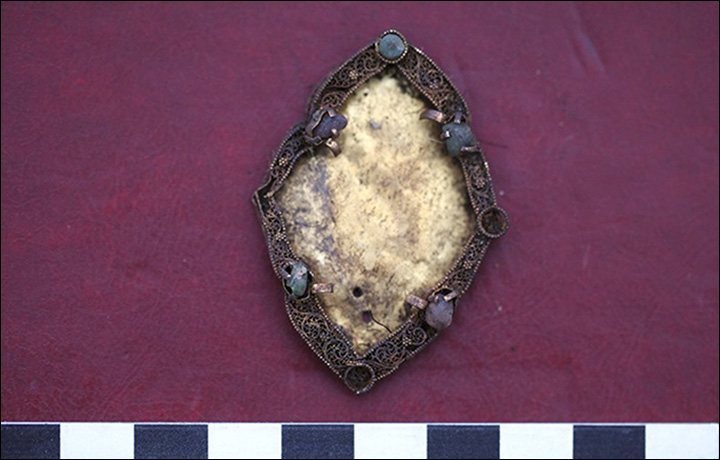 Gold plaque, decorated with filigree and granulation and gems. . Picture here and below: Artur KharinskyThe Mongol 'woman fighter’ was around 30 to 40 years old and was tall for her time - some 180 centimetres in height, say archeologists from Irkutsk National Research Technical University who took part in excavations at two sites in the Khövsgöl (Khubsugul) area in northern Mongolia, close to the Russian border. Gold plaque, decorated with filigree and granulation and gems. . Picture here and below: Artur KharinskyThe Mongol 'woman fighter’ was around 30 to 40 years old and was tall for her time - some 180 centimetres in height, say archeologists from Irkutsk National Research Technical University who took part in excavations at two sites in the Khövsgöl (Khubsugul) area in northern Mongolia, close to the Russian border.
The suspected female fighter capable of battling men was buried entirely with ‘male items’ in a wooden coffin made of a whole log at Urd Khyar 1 site.
Professor Artur Kharinsky, leader of the expedition, told The Siberian Times: 'The buried person we discovered is a kind of 'Mongolian Amazon', a strong enough lady who can overcome some men. 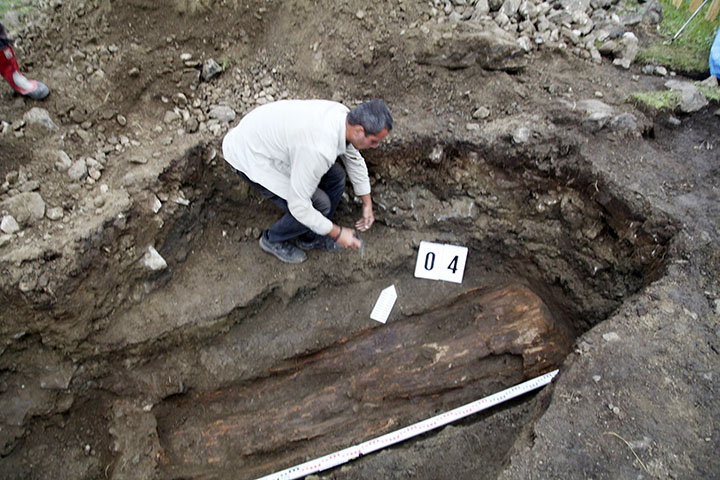 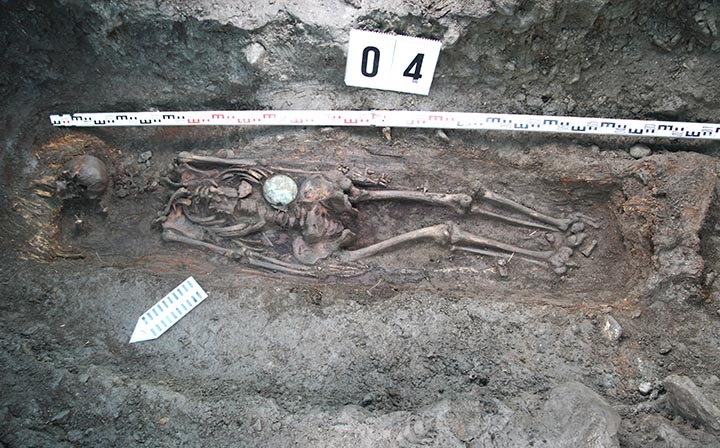 The suspected female fighter capable of battling men was buried entirely with ‘male items’ in a wooden coffin made of a whole log at Urd Khyar 1 site. ‘It can be assumed that she was a warrior, since she was buried with a long iron knife, hatchet, saddle with stirrups and a bronze bowl, an extremely rare attribute for female burials. The suspected female fighter capable of battling men was buried entirely with ‘male items’ in a wooden coffin made of a whole log at Urd Khyar 1 site. ‘It can be assumed that she was a warrior, since she was buried with a long iron knife, hatchet, saddle with stirrups and a bronze bowl, an extremely rare attribute for female burials.
‘She has large limb bones, which indicates her physical strength.’
Despite her physical prowess, she was - by her death - 'seriously ill', said the professor.
'She had lost most of her teeth during her lifetime,’ he explained. The holes in the roots of the teeth were overgrown, and growths appeared on the bones of the jaws.
‘This was definitely not was not some (battle) injury.
‘We do not see any traces of combat injuries on her bones, but we presume that she would have taken part in fights along with men.’
|
|
|
|
Deleted
Deleted Member
Posts: 0
|
Post by Deleted on Sept 8, 2019 1:51:06 GMT -5
‘Amazon woman warrior’ from 14th century found by Siberian archeologists in Mongolia, ConclusionProfessor Kharinsky believes that these precious trophies were brought to this woman by her fiancee or husband, who took part in the conquests in Europe.
He said: ‘These things are clearly of European origin and could be obtained by a Mongol warrior during a campaign in the West, and then presented to his beloved one.
‘These items are not the result of trading, they did not preserve their integrity.
‘They were clearly the result of a share of booty between the warriors.’
Of significance was not the object as a whole, but the precious material it was made of.
'The woman was quite wealthy. In the area of her belt there was a bronze mirror, on the reverse side of which were images of dragons.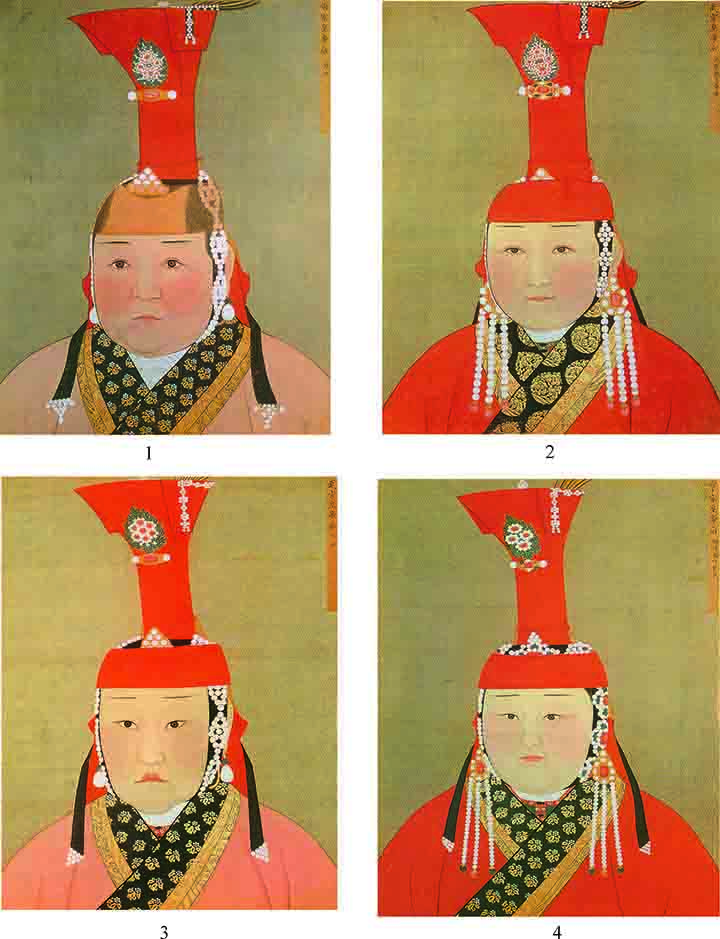 Chinese drawings show wealthy Mongolian women wearing boghta.‘Near the bones of the right leg were found the remains of a birch bark base of the headdress called boghta. Chinese drawings show wealthy Mongolian women wearing boghta.‘Near the bones of the right leg were found the remains of a birch bark base of the headdress called boghta.
‘This headdress is a characteristic part of the costume of Mongolian women of the imperial period.
'Most likely, women did not participate in the campaign to the West.
‘It was attended by men - their relatives, who brought trophies home.'
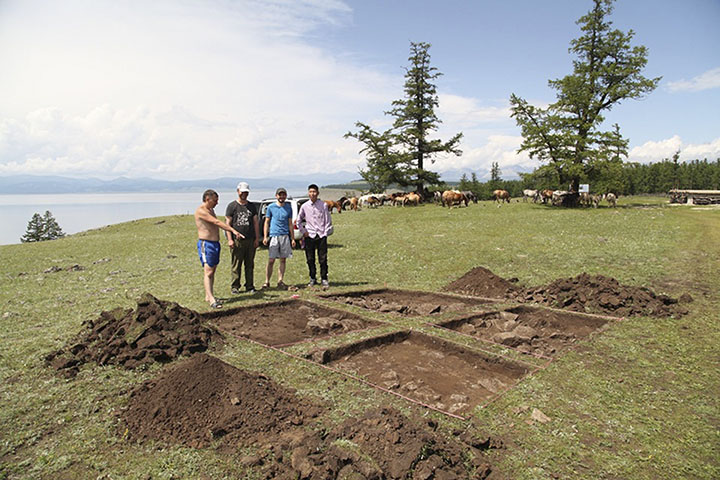 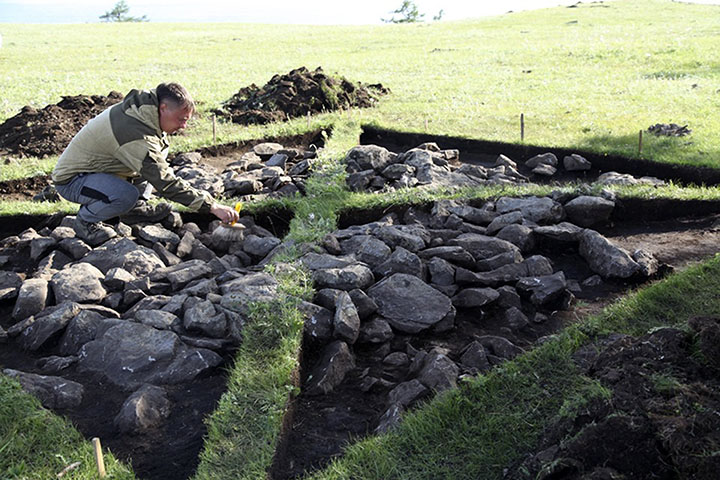 Excavations took place at two sites in the Khövsgöl (Khubsugul) area in northern Mongolia, close to the Russian border.The Mongols surged through such lands as modern-day European Russia, Poland, Hungary, Croatia, the Czech Republic, and southern Germany. Excavations took place at two sites in the Khövsgöl (Khubsugul) area in northern Mongolia, close to the Russian border.The Mongols surged through such lands as modern-day European Russia, Poland, Hungary, Croatia, the Czech Republic, and southern Germany.
All the finds will remain in Mongolia.
Analysis will be conducted in the laboratories of Ulaanbaatar State University. The antiquities will be passed to local museums.
The international team was headed by Professor Artur Kharinsky. Other experts taking part were Professor Dmitry Kichigin, laboratory assistant Matvey Portnyagin, along with students of Irkutsk State University.
The curator of the Mongolian group, teacher Orgilbayar Samdantsoodol and undergraduates of Ulaanbaatar State University also participated in the excavations.
|
|
|
|
Post by kemp on Sept 9, 2019 8:57:09 GMT -5
‘Amazon woman warrior’ from 14th century found by Siberian archeologists in Mongolia, ConclusionProfessor Kharinsky believes that these precious trophies were brought to this woman by her fiancee or husband, who took part in the conquests in Europe.
He said: ‘These things are clearly of European origin and could be obtained by a Mongol warrior during a campaign in the West, and then presented to his beloved one.
‘These items are not the result of trading, they did not preserve their integrity.
‘They were clearly the result of a share of booty between the warriors.’
Of significance was not the object as a whole, but the precious material it was made of.
'The woman was quite wealthy. In the area of her belt there was a bronze mirror, on the reverse side of which were images of dragons. Chinese drawings show wealthy Mongolian women wearing boghta.‘Near the bones of the right leg were found the remains of a birch bark base of the headdress called boghta. Chinese drawings show wealthy Mongolian women wearing boghta.‘Near the bones of the right leg were found the remains of a birch bark base of the headdress called boghta.
‘This headdress is a characteristic part of the costume of Mongolian women of the imperial period.
'Most likely, women did not participate in the campaign to the West.
‘It was attended by men - their relatives, who brought trophies home.'
  Excavations took place at two sites in the Khövsgöl (Khubsugul) area in northern Mongolia, close to the Russian border.The Mongols surged through such lands as modern-day European Russia, Poland, Hungary, Croatia, the Czech Republic, and southern Germany. Excavations took place at two sites in the Khövsgöl (Khubsugul) area in northern Mongolia, close to the Russian border.The Mongols surged through such lands as modern-day European Russia, Poland, Hungary, Croatia, the Czech Republic, and southern Germany.
All the finds will remain in Mongolia.
Analysis will be conducted in the laboratories of Ulaanbaatar State University. The antiquities will be passed to local museums.
The international team was headed by Professor Artur Kharinsky. Other experts taking part were Professor Dmitry Kichigin, laboratory assistant Matvey Portnyagin, along with students of Irkutsk State University.
The curator of the Mongolian group, teacher Orgilbayar Samdantsoodol and undergraduates of Ulaanbaatar State University also participated in the excavations. The steppe regions of Eurasia had some history of female warriors stretching back into the ancient times, from the Sarmatian 'Amazons', to the Mongols, and sporadically amongst the Slav peoples, notably the Russians.  There has been some debate about the Mongolian advances into medieval Europe. They had some successes, the medieval melee warfare tactics weren't that effective against the Mongol forces, although heavily armored Knights and cavalry proved more effective. Better fortifications also helped. There is also the argument that the eastward retreat was in part due to the death of the Mongol Khan Ogedei, one of the sons of Genghis Khan. His mother was Borte Khatun. This is of interest to me as I have recently watched the movie Mongol about the early rise of Temujin who would become Genghis Khan of the steppe.  In the movie he chooses Borte against his father's wishes. I strongly suggest that those who have not watched it go and check it out. I was impressed by the story, drama, acting, location and action scenes. They even made the weapons look like they were forged and crafted in the medieval steppes as opposed to over polished modern wall hangers. Gengis Khan and three of his four sons  |
|
Deleted
Deleted Member
Posts: 0
|
Post by Deleted on Sept 9, 2019 16:32:29 GMT -5
The steppe regions of Eurasia had some history of female warriors stretching back into the ancient times, from the Sarmatian 'Amazons', to the Mongols, and sporadically amongst the Slav peoples, notably the Russians.  There has been some debate about the Mongolian advances into medieval Europe. They had some successes, the medieval melee warfare tactics weren't that effective against the Mongol forces, although heavily armored Knights and cavalry proved more effective. Better fortifications also helped. There is also the argument that the eastward retreat was in part due to the death of the Mongol Khan Ogedei, one of the sons of Genghis Khan. His mother was Borte Khatun. This is of interest to me as I have recently watched the movie Mongol about the early rise of Temujin who would become Genghis Khan of the steppe.  In the movie he chooses Borte against his father's wishes. I strongly suggest that those who have not watched it go and check it out. I was impressed by the story, drama, acting, location and action scenes. They even made the weapons look like they were forged and crafted in the medieval steppes as opposed to over polished modern wall hangers. Yeah, it's a pretty good movie. Shame Sergei Bodrov did not manage to complete the trilogy. |
|
|
|
Post by kemp on Sept 11, 2019 9:32:56 GMT -5
The steppe regions of Eurasia had some history of female warriors stretching back into the ancient times, from the Sarmatian 'Amazons', to the Mongols, and sporadically amongst the Slav peoples, notably the Russians.  There has been some debate about the Mongolian advances into medieval Europe. They had some successes, the medieval melee warfare tactics weren't that effective against the Mongol forces, although heavily armored Knights and cavalry proved more effective. Better fortifications also helped. There is also the argument that the eastward retreat was in part due to the death of the Mongol Khan Ogedei, one of the sons of Genghis Khan. His mother was Borte Khatun. This is of interest to me as I have recently watched the movie Mongol about the early rise of Temujin who would become Genghis Khan of the steppe.  In the movie he chooses Borte against his father's wishes. I strongly suggest that those who have not watched it go and check it out. I was impressed by the story, drama, acting, location and action scenes. They even made the weapons look like they were forged and crafted in the medieval steppes as opposed to over polished modern wall hangers. Yeah, it's a pretty good movie. Shame Sergei Bodrov did not manage to complete the trilogy. How cool was the battle scene at the end, Temujin's elite Mongol warriors riding into the opposing enemy force, swords drawn in each hand. Spoiler alert. |
|
Deleted
Deleted Member
Posts: 0
|
Post by Deleted on Sept 15, 2019 1:59:22 GMT -5
The art of Talgat Tleuzhanov of the Kazakh republic. Kazakh Sonja  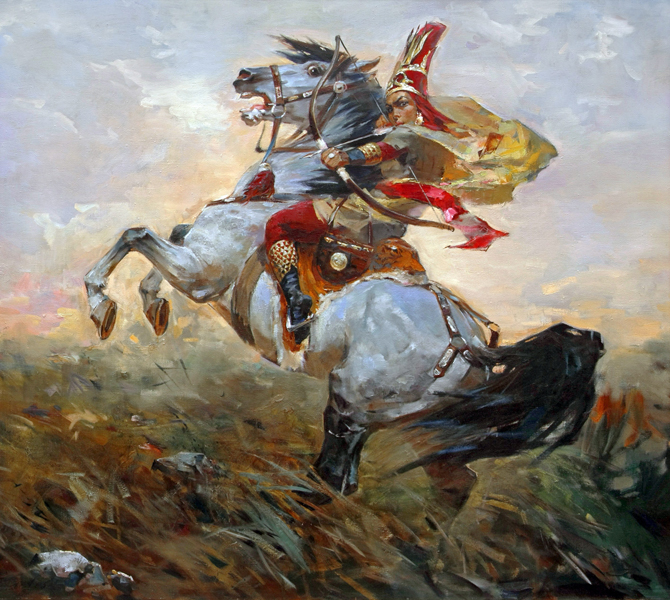 THE QUEEN TOMIRIS  Attack
|
|
Deleted
Deleted Member
Posts: 0
|
Post by Deleted on Sept 18, 2019 10:51:44 GMT -5

CLASSICAL WRITINGS OF THE ISLAMIC WORLD: PERSIAN HISTORIES OF THE MONGOL DYNASTIES, VOLUME 3 BY RASHIDUDDIN FAZLULLAH (TRANSLATED AND ANNOTATED BY WHEELER M. THACKSTON
CONTENTSTranslator's Preface vii Maps xv Genealogical and Dynastic Charts xxii Introduction by Wheeler M. Thackston 1 Note to the Contents 7 THE COMPENDIUM OF CHRONICLESPART 1. HISTORY OF THE EMERGENCE OF THE TURKIC NATIONS AND HOW THEY DIVIDED INTO VARIOUS TRIBES, ALONG WITH A SUMMARY HISTORY OF THE ANCESTORS OF EACH NATION
Chapter I. The History and Stories of the Nations of Oghuz and the Twenty-Four Branches of his Sons and their Offspring and Some of his Brothers and Cousins Who Joined him 20 Chapter II. The Turkic Nations that are now called Mongols but in Times Past were Separate Nations, Each with its own Language and Name 27 Chapter III. The Turkic Tribes that have also had Separate Monarchs and Leaders but do not have a Close Relationship to the Tribes Mentioned in the Previous Division or to the Mongols yet are Close to them in Physiognomy and Language 43 ChapterIV. The Turkic Tribes that were Anciently Styled Mongol, from which many Tribes have come into Being 56 PART II. HISTORY OF THE RULERS OF THE MONGOL AND TURKIC PEOPLES AND OTHERSChapter I. The History of Genghis Khan's Forebears and Ancestors 80 Chapter II. The History of Genghis Khan and his Illustrious Some of whom have become Rulers in Every Era, Others of whom have not been Rulers of a Specific along with a Summary Account of the Rulers of the World Contemporary with them down to the Year 705 of the Hegira 101 Glossary 534 List of Works cited 543 General index 548 |
|
Deleted
Deleted Member
Posts: 0
|
Post by Deleted on Sept 20, 2019 1:01:12 GMT -5
The Physical Appearance of Temüjin/Genghis Khan: According to the Earliest Written Accounts.
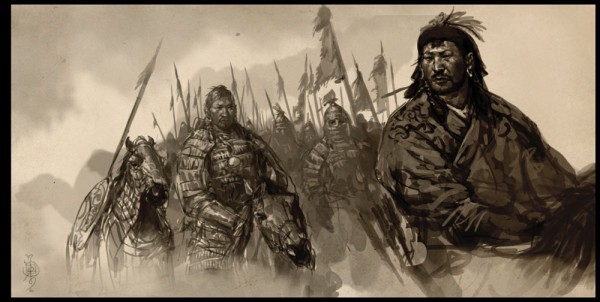
1. The Secret History of the Mongols 'Fire in his eyes and light in his face'
In section 61 of the Secret History, upon seeing the young Temüjin (Genghis) Dei-Sechen, father of Börte says: 'This boy of yours has fire in his eyes and light in his face.' This is seen as a sign of intelligence according to Urgunge Onon, a Mongolian translator of the Secret History. In section 66, When Yesügei saw Dei-Sechen's daughter Börte, there was light in her face and fire in her eyes. Scholars tend to disagree about the exact meaning of Börte. The mythological wolf ancestor of the Mongols was called Börte Chino. Cleaves interprets Börte in Börte Chino as 'Bluish' De Rachewititz as 'blue-grey' Urgench Onon goes for a 'greyish white' Alan Qo’a the Fair and the Shining Man: Ancestors of Genghis Khan.The beautiful Alan Qoa, was married to Dobun Mergen. They had 2 sons, Dobun Mergen also adopted a boy from another tribe. After Dobun Mergen died she had 3 more sons. The 2 sons of Dobun Mergen accused their mother of sleeping with their adopted brother. This is the earliest extant source; The Secret History of the Mongols, sections 17- 22. [17] Not long afterwards, Dobun-mergen died. After his death, despite the loss of her husband, Alan Qo’a bore three more sons called Buqu-qadagi, Buqatu-salji, and Bodonchar-mungqaq.
[18] Belgünütei and Bügünütei, the two sons born earlier to Dobun-mergen, talked together about their mother Alan Qo’a behind her back: This mother of ours has produced three sons, without [our father’s] older brother, younger brother, or cousins or any husband. Only the Ma’aliq Baya’ud man lives in this yurt. They are probably his three sons.’ Alan Qo’a sensed what they were saying behind her back.
[19] One spring day, after boiling some dried mutton, she made her five sons, Belgünütei, Bügünütei, Buqu-qatagi, Buqatu-salji, and Bodonchar-mungqaq, sit down in a row. She gave each an arrow-shaft, saying: ‘Break it.’ They broke the arrow-shafts easily and threw them aside. Again, she took five arrow-shafts and bound them together. She gave the five bound shafts to each in turn, saying: ‘Break them.’ Each tried, but none succeeded.
[20] At this, Alan Qo’a said to her two sons Belgünütei and Bügünütei: ‘You have doubted me. You have talked together, saying: “Whose are these three sons that she has borne? Whence did they come?” It is right for you to be suspicious.
[21] Every night, a shining yellow man came into the yurt through the light of the smoke-hole and over the top of the door. He caressed my belly and his light sank into it. He [slunk] sheepishly away like a yellow dog by the light of the sun and moon.’
Why do you talk unwisely? Evidently it is a sign that they are sons of Heaven. Why do you compare them to the black-haired commoners?When they become lords of all, the common people must understand.
[22] Again, Alan Qo’a spoke with her five sons: ‘All five of you were all born of this same belly. Alone, you can be broken easily by anyone. Together and of one mind, like bound arrow-shafts, none can easily vanquish you.’ Not long afterwards, their mother Alan Qo’a passed away.So far, a direct translation in the relevant section of Rashid-al-Din's 'Compendium of Chronicles' has managed to be elusive, but, when I get hold of a direct translation I will post it on this thread. 2. Minhaj al-Siraj Juzjani
Cats' Eyes of Genghis KhanMinhaj al-Siraj Juzjani, was a historian who served at the court of the Turkish Mamluk Sultanate in India. Juzjani described an older Genghis as 'a man of tall stature, of vigorous build, robust in body, the hair on his face scanty and turned white, with cats' eyes, possessed of dedicated energy, discernment, genius, and understanding, awe-striking, a butcher, just, resolute, an over- thrower of enemies, intrepid, sanguinary, and cruel.'
Juzjani completed his history 'The Tabaqat-i Nasiri' in 1260. 3. Ata-Malik JuvainiHe was a Persian historian and completed 'The History of the World Conqueror' in 1260. He stayed in Mongolia at least a couple of times and left the Mongol capital Karakorum in 1252/3. Juvaini accompanied the 1st Ilkhan of Persia Hülegü Khan (grandson of Genghis) when the Mongols destroyed the Assassin order of Alamut in 1256. Juvaini was also present at the fall of Baghdad in 1258. Juvaini had plenty to say about the genius of Genghis Khan and his campaigns in Central Asia and Iran, but, did not write about the appearance of Genghis Khan. The work of Juvaini was an important source for Rashid-al-Din. 4. Rashid-al-Din (1247–1318)
Rashid-al-Din, was the vizier of the Ilkhan, Ghazan (1271–1304) and a historian, among other duties, basically Rashid was a man of many talents. The work of Juvaini was an important source for Rashid-al-Din, as well as the now, non-extant 'Altan Debter' or Golden Book. 'Ruddy Complexion' of the Genghis clan.What Genghis had to say when he first laid eyes on his grandson Kublai. 'Qubilai Qa'an was the fourth son of Tolui Khan by Sorqoqtani Beki. His nurse was the mother of Moge, a concubine of the Naiman people. It chanced that he was born 2 months before Moge, and when Chingiz-Khan's eye fell upon him he said:
"All our children are of a ruddy complexion, but this child is swarthy like his maternal uncles. Tell Sorqoqtani Beki to give him to a good nurse to be reared."
He was given to Moge's mother, Saruq by name. Two months later when Moge was born his mother gave him to a nurse of the Tangqut people to be reared, and [she] reared Qubilai Qa'an herself until he had grown up. She regarded him as her own child and cared for and protected him in every way. The Qa'an held her in the highest honor, and when she died he constantly remembered her and used to give alms for the sake of her soul.' Rashid-al-Din, translated by John Boyle, The Successors of Genghis Khan, 1971, p.241 BibliographyCleaves, Francis Woodman - The Secret History of the Mongols, Harvard University Press, 1982 De Rachewiltz, Igor - The Secret History of the Mongols: A Mongolian Epic Chronicle of the Thirteenth Century, 2 volumes, EJ Brill, 2004 Juvaini, Ata-Malik - Genghis Khan: The History of the World-Conqueror, translated by John Andrew Boyle, University of Manchester Press, 1997 Onon, Urgunge - The Secret History of the Mongols : The Life and Times of Chinngis Khan, Taylor Francis Ltd, 2001 Rashid-al-Din - The Successors of Genghis Khan, translated by John Andrew Boyle, Columbia University Press, 1971 Here's a little bit more from Rashid-al-Din's Compendium of Chronicles: Second are the Niru'un who are called Qiyat and consist of two branches. The "real" Qiyat, the Yürkin, the Changshi'iut, and Qiyat Yasar, and the Qiyat who are the Borjiqin, which means dark-eyed, and the the branches to whom belong Genghis Khan's father and who are attributed to his family and that of his father. Rashiduddin Fazlullah (translated by Wheeler M. Thackston), Compendium of Chronicles, 2012, page 19. …and now in complete contradiction. Although Genghis Khan and his forefathers and brothers were of the Qiyat tribe, the sons of Yesügei Bahadur, Genghis Khan’s father, were called Qiyat and Borjiqin. (In the Turkish language Borjiqin means someone with yellowish gray eyes.) They were extremely brave and valiant warriors… Compendium of Chronicles, page 57 The yellowish-gray eyes in the rounded brackets in the excerpt above have been introduced by the translator Wheeler M. Thackson, not by Rashid-al-Din. The addition of the annotation by Thackston can probably be explained by the excerpt below concerning Genghis Khan’s ancestors. The third son was Yesügei Bahadur, the father of Genghis Khan. The Qiyat and Borjiqin are descended from him. Borjiqin means having gray eyes, and as it happens the sons who were born to Yesügei Bahadur and to his sons and offspring down to the present mostly have gray eyes and are of a yellowish color. This is attributed to the fact that when Alan Qo’a was pregnant she said, “A light like a person comes before my eyes at night and then goes away. It is of a yellow color in form and has gray eyes.” When this trait reemerged in the eighth generation, which was Yesügei Bahadur, they said it was the sign Alan Qo’a had spoken of, that her sons would be rulers, and it indicated the truth of her words and it was imminent. Compendium of Chronicles, page 96 I have only had the book a couple of days now and will post other snippets of interest in the future. It has taken so long for Rashid-al-Din's history to be translated into English that some historians have, I suspect, got a little carried away with the description of Genghis Khan as a blue/green or gray eyed warrior with red hair. The real difficulty lies in the fact that in order to fully comprehend the original source material the historian needs to master several languages. I'd imagine mastery of the Turkic and Mongolian languages would prove extremely helpful, an absolute must. What about the sources from their conquered adversaries, from the established civilisations of China and Persia? Again, I'd say an absolute must. Furthermore, there can be found a number of original sources in other languages; for example in Arabic, Hungarian, Slavic and even Armenian - that's an awful big ask for any historian. A truly monumental task in my opinion. To summarise, for now, according to Rashid-al-Din's history:
1. Yesügei and his descendants were known for having Gray yellowish eyes.
A bit like the 'cat's eyes' as described by Juzjani (quote can be found above). Juzjani is the only contemporary writer to have actually seen Genghis Khan! 2. To add further confusion in the introduction of the history Rashid states that the ancestors (Qiyat who are the Borjiqin) of Genghis have dark eyes. 3. No mention of red hair, yet.
That's all for now. Let's see if I can unearth anything else of interest in this translation. I have found a few deviations from the Secret History of the Mongols, more on that later. |
|
Deleted
Deleted Member
Posts: 0
|
Post by Deleted on Sept 21, 2019 2:08:11 GMT -5
|
|